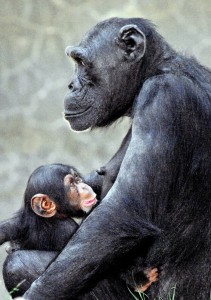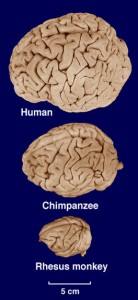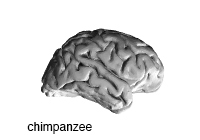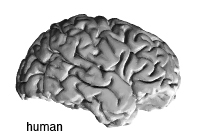Chimpanzee Brain Facts

Order: Primates
Suborder: Haplorrhini
Family: Hominidae
Genus and species: Pan troglodytes
Subspecies: P. t. schweinfurthii, P. t. troglodytes, P. t. ellioti, P. t. verus
Conservation status: Endangered (IUCN Red List)
Life span: 40 to 45 years (wild), more than 60 (captive)
Total population: 172,700 to 299,700 (wild), 1,450 (captive)
Habitat range in the wild: Equatorial Africa, from southern Senegal across the forested belt north of the Congo River to western Uganda and western Tanzania
Gestation: 8 months (240 days)
Body height: 816 mm (M & F)
Body weight: 40 to 60 kg (M), 32 to 47 kg (F)
Brain weight: 384 g (0.85 lb)
Chimpanzees, along with other great apes such as bonobos, gorillas, and orangutans, are among humans' closest living relatives. Through studying their shared evolutionary and genetic heritage, we gain valuable insights into the complex web of relationships that connect humans to these remarkable primates.
Chimpanzee brains are about one-third the size of human brains. This size difference mostly comes from the neocortex, a part of the brain that has expanded substantially in humans. The neocortex includes a set of regions, called the association cortex, that are active during advanced cognitive skills like using language, understanding social interactions, and solving problems.

neurosciencelibrary.org
Even though humans and chimpanzees have differences, they also share many ways of thinking, communicating, and feeling. This happens because their brain structure and function are quite similar. Chimpanzees take a long time to grow up, like humans do, during which they learn to socialize and their brain structure can be influenced significantly by what they experience and learn.
Chimpanzee brains have a very folded neocortex, which is related to their relatively large size. There are a few other interesting things about chimpanzee brains that are similar to human brains:
- They have areas in their brains that are like Broca's and Wernicke's areas in humans, which help with language and understanding speech. These areas are located in similar parts of the brain in chimpanzees as they are in humans.
- There are special cells called von Economo neurons in certain parts of the brain, like the anterior cingulate and frontoinsular cortex, that are found in both chimpanzees (and other great apes) and humans. These cells might be important for understanding feelings and social interactions.
- The way different parts of their brains are connected and work together is more complex in chimpanzees, especially in areas like the arcuate fasciculus and the "mirror neuron" system. These brain pathways are involved in functions like understanding what others are doing and imitating them, as well as language.
While there are differences between human and chimpanzee brains, there are also many fascinating similarities that help us understand both our closest living primate cousins and ourselves better.
Comparison of human and chimpanzee brain size growth
| Average neonatal brain size (g) | Average adult brain size (g) | % adult brain size at birth | Age 90% of adult brain size attained | Age at sexual maturity (years) | Years from adult brain size to maturity (years) | % subadult period left after reaching adult brain size | |
|---|---|---|---|---|---|---|---|
| Human | 364 | 1,352 | 27% | 5 | 19.5 | 14.5 | 74% |
| Chimpanzee | 137 | 384 | 36% | 4 | 13.3 | 9.3 | 70% |
Source: Robson SL, Wood B (2008) Hominin life history: reconstruction and evolution. J Anat. 212: 394-425.
Download STL files of chimpanzee and human brains to print 3D models
(click on the images of the brains below to download)



